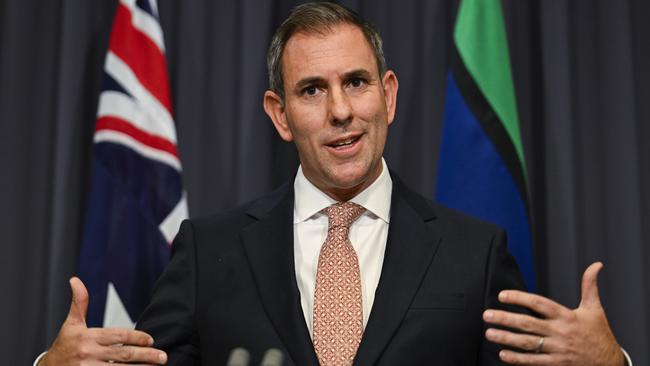
As the mining tax was to Wayne Swan, the 30 per cent tax on superannuation balances of more than $3m is to Jim Chalmers. In both cases, they thought the new tax imposts were acts of genius designed to produce gushing torrents of new government revenue.
In fact, these taxes are akin to their Waterloo, ending promising careers based on a stubborn refusal to listen to the people who really understand complex tax matters. Preferring to take advice from commercially naive boffins in Treasury, these men pushed on while being egged on by parts of the equally gullible media.

It’s worth briefly recounting the fate of the mining tax. The basic idea was the government could identify “above-normal” profits being made by resources companies and impose a high rate of tax on these super-profits without there being any adverse consequences for production or investment. Billions of dollars would be raised without imposing any real costs on the economy.
That was the theory, at least. But in practice, there is no accurate way of identifying “above-normal” profits. And because resource projects stretch over many years, covering the cost of past investments is a central issue.
The short of it was that Swan’s mining tax generated no revenue – in fact, it cost the government money in the first year – and caused extreme controversy and turmoil in the investment community. By the time it was scrapped by the Abbott Coalition government, Swan’s reputation as a money man was effectively shot.
Given Chalmers had a front-row seat to the development and fate of the tax, it’s surprising that he would embark on his own divisive tax adventure in the form of Division 296. To be sure, the idea of imposing a surcharge on large superannuation accounts is not quite as radical as a mining super-profits tax. But we should not forget the affected superannuants have amassed their large accounts using perfectly legitimate means.
Where Chalmers has floundered is his choice not to index the cut-off ($3m) as well as the highly contentious and unworkable decision to tax unrealised capital gains. Only allowing for unadjusted losses to be carried forward is also an issue: gosh, even under Swan’s mining tax, losses were adjusted by the long-term government bond rate.
Let’s take the first issue. The failure to index will mean more and more superannuation members will be dragged into paying higher tax, with potentially 10 per cent of all members affected into the future. In the meantime, the strong message will be conveyed to those in the accumulation phase to walk away from further investing in superannuation as far as possible.
It’s hard to see how this outcome would be welcomed by Chalmers, or the industry funds, for that matter. The “soak the rich” rationale, which is the current favoured justification of Chalmers for the new impost, will start to wear thin. The most contentious aspect of the proposal is the taxing of unrealised capital gains, meaning superannuation members will be taxed on paper profits, not actual earnings, that may never materialise. It is in fact even worse because tax may be levied on an asset that is under water. This is because the starting point is July 1, 2025, and the new tax impost ignores the purchase price of the asset.
Let’s be clear where this is really coming from. The aim is to damage the self-managed superannuation sector and to accommodate the industry funds whose IT systems have simply not been up to the task of calculating the individual tax imposts on their few members with large accounts.
The trustees of industry super funds, with their close connections to unions and hence to Labor governments, regard SMSFs as the enemy. These same trustees were able to wage an effective campaign against the retail funds, but the SMSFs have held their ground.
It is currently estimated that of the $4.2 trillion of funds in superannuation, $1.1 trillion is held in SMSFs. The handful of very large funds of more than $100m are all SMSFs and exist for historical reasons that no longer apply. Industry funds pay tax at the fund level. When asked by the naive Treasury officials undertaking the superficial consultation about implementing the tax, the simplistic response was to take the difference between the superannuation balances in two years, adjust for contributions and withdrawals, and to impose the additional 15 per cent tax on the difference in the balances above $3m.
While this might work at the level of a large industry super fund, this is simply impractical for SMSFs. Many of these funds contain lumpy, unlisted assets – farms, buildings, businesses – and there is no requirement that these assets be valued every year. At the very least, a shortage of registered valuers will make this approach unworkable.
Very strong disincentives will also be created for any further investment in unlisted assets. The requirement for liquidity to pay the additional tax will have this effect. As various industry leaders have pointed out, there will be broader damaging economic consequences, including in the green energy space. The fear that taxing unrealised gains will be extended to other areas will have a similar impact.

One further flank where Chalmers is weak relates to the tax treatment of those on defined benefits as opposed to those on defined contributions. Long-serving politicians, past and some current public servants, military personnel and some others fit into this former category.
There are also some constitutionally protected persons – judges, some state public servants and assorted others – who will never have to pay the new tax. Chalmers has meekly accepted this latter limitation. The challenge is to ensure the tax burdens between the two categories of superannuants is equivalent. While it is true that those on defined benefit pensions pay normal income tax rates with a rebate, there is no equivalent impost to the contributions and earnings taxes that most superannuants face.
For all the bluster about the Prime Minister being equally affected, this is simply not the case. The decision to use the Family Court method of calculating the implied capital base is very generous to those on defined benefits. And over time, the tax impost on those on defined benefits will fall, which contrasts with other affected superannuants. The fact is those on defined benefits stand to do very well out of the deal, which could be politically difficult.
The real tragedy is that there are alternatives to Chalmers’s new tax. For instance, he could have opted for a series of deeming rates for different classes of assets to operationalise the higher tax. He could have stuck with the current system. Chalmers can already kiss goodbye to the expected revenue as people withdraw from superannuation and seek out other tax-effective vehicles, including an upgraded family home. Virtually all those with large super accounts have passed the preservation age and can immediately withdraw funds without penalty.
My advice to Chalmers is to avoid his Waterloo. He can achieve almost everything he is aiming for without attempting to tax unrealised gains.
He should simply index the $3m figure: he might even do this in the context of initiating a broad inquiry into the taxing of savings with a view to bringing a greater degree of uniformity and rationality to the system.






